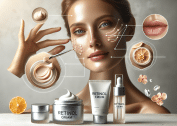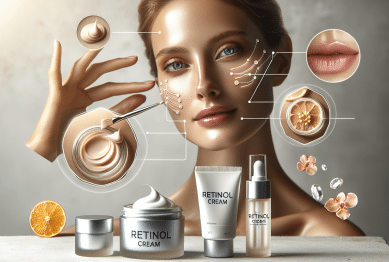Explore how hyaluronic acid transforms skincare routines, supports deep hydration, and helps foster a natural glow. This guide unpacks what makes it a favorite in beauty circles, with tips on maximizing results and understanding the science behind its remarkable skin benefits.
Discovering Hyaluronic Acid and Its Role in Skincare
Hyaluronic acid is found naturally in the body, especially in skin, connective tissue, and eyes. It excels at retaining moisture, which makes it a sought-after ingredient in modern skincare. By acting as a humectant, hyaluronic acid draws water into the skin, creating a plumper, dewier appearance that many people find rejuvenating. It doesn’t simply coat the outer layer but works below the surface, making it one of the building blocks of an effective hydration-focused regimen.
As popularity around skin health has soared, hyaluronic acid serums and creams have quickly become staples across age groups and skin types. Dermatologists frequently recommend it since its lightweight yet deeply moisturizing nature works for oily, dry, and combination skin without causing breakouts or greasiness. The molecule holds up to 1,000 times its weight in water, giving users a path to a more bouncy, supple look with consistent use (Source: https://www.ncbi.nlm.nih.gov/pmc/articles/PMC7696161/).
It’s not just the beauty industry touting these advantages; the science supports it. Studies reveal that topical hyaluronic acid boosts skin elasticity and moisture while providing an immediate smoothing effect. Unlike heavier creams that may suffocate pores, these formulations refresh the skin’s barrier and help defend against environmental stressors. Knowing what hyaluronic acid is, and how it’s integrated in skincare, builds a solid foundation for healthier habits and better results.
How Hyaluronic Acid Works Beneath the Surface
Not all moisturizers are equal. Hyaluronic acid works by binding water molecules within the epidermis, supporting protective skin layers that keep irritants at bay. Its unique structure allows it to function as a cushion and lubricant for joints and tissue—even more proof of its versatility and value. When applied topically, it penetrates deeply, hydrating skin where it truly counts (Source: https://www.ncbi.nlm.nih.gov/pmc/articles/PMC3583886/).
This natural, gel-like substance also helps strengthen the skin’s barrier against harsh environmental elements like wind, sunlight, and pollution. It’s especially valuable as people age because natural hyaluronic acid stores decline, leading to lines and dehydration. By supplementing with the right products, it’s possible to minimize those effects and keep skin resilient for longer.
There’s a reason it is central to so many dermatologist-approved regimens. Hyaluronic acid delivers a visible boost in luminosity and texture in hours, but with regular use, its cumulative impact on plumpness and fine lines can be significant. Whether included in serums, masks, or moisturizers, it amplifies other ingredients, maximizing the impact of your daily routine.
Choosing the Right Hyaluronic Acid Product for You
With so many skincare options promising radiance and hydration, how do you pick the right hyaluronic acid product? Consider formulation first—serums are known for their high concentration and fast absorption, while creams combine hyaluronic acid with nourishing lipids for more lasting effects. Product labels often differ; seek out those with multiple molecular weights that hydrate at various skin depths for comprehensive benefits (Source: https://www.aad.org/public/everyday-care/ingredients/ingredient-hyaluronic-acid).
Quality matters as much as quantity. Dermatologists recommend checking the ingredient list for stabilizing components, like vitamin B5 or ceramides, which elevate the hydrating effects of hyaluronic acid. Avoid products laden with fragrances and alcohols—these may counteract hydration or trigger skin irritation, especially in sensitive types. Trusted clinical-grade products often share their research or certifications, which may help in your selection.
Personal routine and skin type also guide decisions. Oily skin thrives on lightweight, water-based serums. Those with dryness may notice better results from thicker creams paired with humectants and occlusives for sustained moisture. There’s no universal rule, so patch-testing and gradually introducing new products can ease the transition and prevent unwanted reactions. Learning what suits your needs ensures satisfaction in the long run.
Maximizing Results: Application Techniques and Timing
Applying hyaluronic acid seems straightforward but timing and placement make a difference. Experts recommend layering hyaluronic acid on freshly cleansed, slightly damp skin. This boosts absorption and lets the molecule draw in optimal water from the environment (Source: https://www.dermstore.com/blog/top_ten/top-benefits-of-hyaluronic-acid/).
Gently pat the serum into the skin without rigorous rubbing. Cover with a moisturizer that helps lock in water—think of it as sealing hydration beneath a protective layer. For those using additional actives, hyaluronic acid fits best between cleansing and heavier treatments. Morning or evening use is safe, depending on your daily preferences.
People in arid climates might enhance efficacy by pairing hyaluronic acid with products made to bolster water retention, like squalane or facial oils. Steer clear of applying it to completely dry skin; otherwise, it may pull moisture from deeper tissues, worsening dryness. Building a habit of thoughtful, well-timed application refines outcomes and boosts confidence in your skincare process.
Combining Hyaluronic Acid with Other Skin Health Strategies
Beautiful skin is rarely the work of one ingredient alone. Hyaluronic acid shines brightest alongside a balanced skincare routine featuring broad-spectrum sunscreen, gentle cleansers, and supporting antioxidants. Vitamin C serums, for example, complement hyaluronic acid by brightening and protecting against free radicals simultaneously (Source: https://www.health.harvard.edu/blog/skincare-tips-2018011913144).
Eating a nourishing, hydrated diet magnifies skincare results. Foods rich in water content, antioxidants, and omegas help reinforce the benefits of topical products. Think berries, leafy vegetables, salmon, flaxseed, and nuts—all of which supply nutrients vital for robust skin integrity and minimal irritation. A holistic approach harnesses beauty from the inside out.
Don’t overlook lifestyle factors. Managing stress and ensuring quality sleep encourage the body’s natural production of hyaluronic acid and collagen. Protect from UV exposure, avoid harsh exfoliants, and stay hydrated throughout the day. Together, these steps let hyaluronic acid deliver its fullest potential for radiant, long-lasting results that go beyond the surface.
Debunking Myths and Exploring New Frontiers
Social media occasionally shares claims about hyaluronic acid that can be misleading. For instance, it does not increase pore size nor does it trigger acne, as scientific studies have confirmed its non-comedogenic nature. It is well tolerated by most skin types, even those prone to redness or irritation, making it one of the safest choices for sensitive skin (Source: https://www.ncbi.nlm.nih.gov/pmc/articles/PMC6204628/).
Innovations in skincare now include injectable forms of hyaluronic acid for even longer-lasting plumpness and wrinkle reduction. These techniques, often performed by medical professionals in controlled settings, offer a non-surgical avenue to enhance facial structure. However, they’re distinct from over-the-counter options and should not replace a robust daily routine without expert guidance.
As research progresses, new delivery systems and eco-friendly formulations are emerging, making this beloved molecule more effective and sustainable. Staying up to date on scientific advances and reading ingredient labels carefully helps users sift truth from fiction. Curiosity and exploration lead to informed, confident skincare choices that honor both tradition and innovation.
References
1. Szentiványi, A. et al. (2020). Hyaluronic acid in cosmetic products: A review. Retrieved from https://www.ncbi.nlm.nih.gov/pmc/articles/PMC7696161/
2. Papakonstantinou, E. et al. (2012). Hyaluronic acid: A key molecule in skin aging. Retrieved from https://www.ncbi.nlm.nih.gov/pmc/articles/PMC3583886/
3. American Academy of Dermatology Association. (n.d.). Hyaluronic acid: Overview and evidence. Retrieved from https://www.aad.org/public/everyday-care/ingredients/ingredient-hyaluronic-acid
4. Dermstore Editors. (n.d.). Benefits of hyaluronic acid. Retrieved from https://www.dermstore.com/blog/top_ten/top-benefits-of-hyaluronic-acid/
5. Harvard Health Publishing. (2018). Skincare tips dermatologists use. Retrieved from https://www.health.harvard.edu/blog/skincare-tips-2018011913144
6. Ghersetich, I. et al. (2018). Hyaluronic acid in skincare: Clinical evidence and emerging trends. Retrieved from https://www.ncbi.nlm.nih.gov/pmc/articles/PMC6204628/









